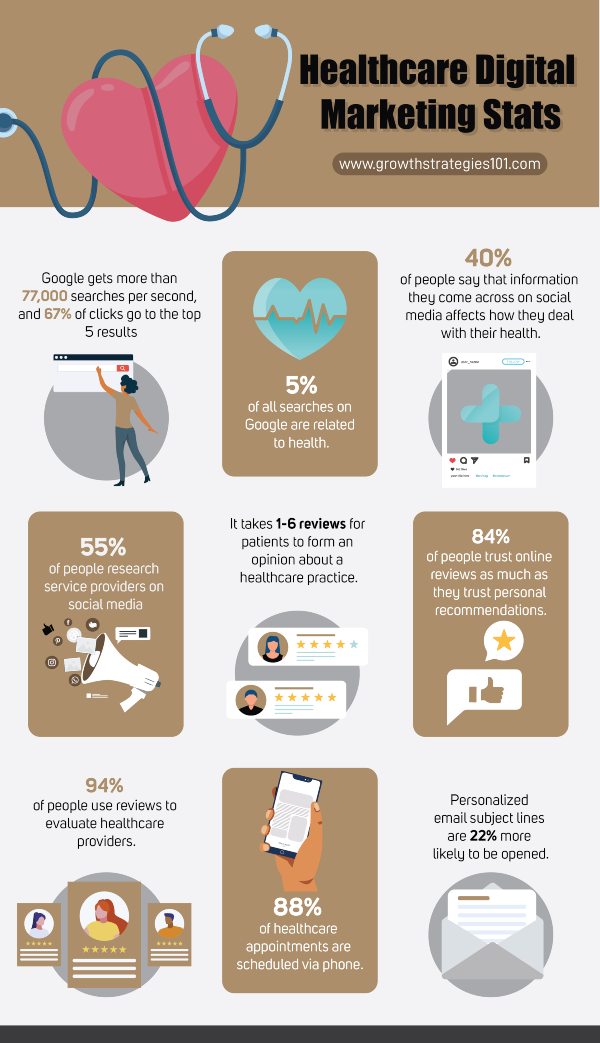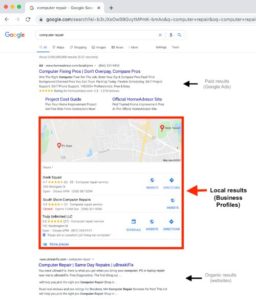Healthcare Marketing Strategy
The internet has changed the world in ways that we could never have imagined. It has become many people’s first destination whenever they need to find products, services, or just some answers to their questions.
This article will hopefully enlighten you on some ways to increase your online presence, develop some online authority, and find new patients for your medical practice.
Ideally, whenever patients search for hospitals or doctors in your city, your site should be among the first results they see. If they search for information about a certain condition, your blog post covering that topic should pop up.
And if they’re looking to purchase over-the-counter medication, your e-commerce store should show up in the results.
If you can dominate the internet in such a way, then you will transform your medical practice into an online empire. You will create additional revenue streams that most hospitals and clinics cannot even dream of. This article will go over 15 effective digital marketing strategies for doctors, clinics, hospitals, and all other medical practices.

Related: Digital marketing strategies for dentists
15 Digital Marketing Strategies for Doctors, Clinics, and Hospitals
1. Get an optimized website
A website is your own personal piece of real estate on the internet, akin to owning a clinic where patients can walk into.
Search engines like Google work by aggregating information from different websites across the web, and then presenting the most relevant information based on what a user is searching for.
If you have a website, whenever people search for information related to your healthcare services, then it will get presented to them. For instance, if they are searching for doctors in your location, then your site will show up on the results page.
The purpose of a website is to attract as much relevant traffic as possible. With traffic comes opportunities that can be converted in various ways. You can persuade your visitors to book a consultation with you, sell them products, redirect them to your blog, etc.
The most important thing to keep in mind when building your website is that the quality of the user experience matters a lot. User experience is simply how easy it is to navigate, how fast it loads, how responsive it is. A responsive site is a site that works well on all devices, from smartphones to tablets and PCs.
Google always favors websites that provide an outstanding user experience. If you can impress Google, then you’re likely to get lots of traffic.
Most of the ideas discussed in this post bank on having a website and driving traffic to it, so please make it a priority for your medical marketing strategy.
Wix is a fantastic website builder you can use to build one if you don’t wish to spend money on expensive developers. The platform is designed to help non-technical people build advanced websites using drag and drop features.
Wix also has hundreds of ready-made website templates that you can add to your site with just one click, and then just edit the content to reflect your practice. It can literally take you just a day to build your medical website.
2. Set up PPC ads
Pay-per-click, or PPC, is a type of paid advertising model whereby ads get served to users as they browse the internet, however the advertiser only pays for the clicks.
Majority of the ads you see online are PPC. It’s one of the best advertising models because it gives you the most value for money. For instance, if 100 people see your ads, but only 10 people click on them, you’ll only get charged for the 10 clicks despite the fact that 90 other people saw them.
Another great thing about PPC, specifically on Google Ads, is that it gives advertisers advanced targeting options to help them pinpoint people that might be interested in their services.
An advertiser can target users based on their age, gender, location, interests, and the keywords that they’re searching on Google.
For example, if you are a physician who’s based in Dallas, you can set up Google ads that only show up whenever people search for the phrase “Physicians in Dallas”. You can also target people who are actively researching specific health-related conditions.
PPC ads are one of the best ways to drive relevant traffic to your website. They are quite easy to set up and are relatively inexpensive.
You can start an online marketing campaign on Google Ads with a budget of just 10 – 20 dollars per day, just to test it out for a short period. If the outcome is positive, then you can gradually increase the daily budget so your ads get shown to more people.
Related: 10 Powerful Customer Acquisition Strategies to Boost your Sales
3. Set up retargeting ads
Retargeting is a popular advertising model that enables you to show ads to people who previously interacted with your site.
Whenever a user lands on your site, it’s pretty clear that something attracted them to it. Maybe they were looking for a doctor or a physician who matches your description, or they just got drawn to a piece of content that you published.
The problem is that majority of website visitors have such a short attention span due to the number of distractions on the internet. They may have been browsing your site, however got distracted by something else on social media or on their smartphone, and forgot to return.
With retargeting, you’re simply reminding them of your existence. They already showed that they were interested in something you have to offer.
Your ads can push them to take your desired call-to-action since they already have some familiarity with you. The two most popular retargeting platforms are Google Ads and Facebook Ads.
4. Search Engine Optimization
Search Engine Optimization, or SEO, is the practice of increasing a website’s authority to help it rank higher on search engines like Google. Whenever people search for information on the internet, there are probably thousands of websites that contain relevant content. SEO is what determines which sites Google will actually show.
A site that has been optimized will likely appear on Google’s first page, whereas a similar website that has not been optimized will appear on the tenth page. Majority of Google users only visit websites on the first page.
SEO is a continuous process that mainly involves building backlinks that point to a website, amongst other things. A backlink is simply a link on another website pointing to your website. Google uses your back link profile as an indicator of how important your site is.
Since SEO can be a tedious and time-consuming process, I would recommend you outsource the task to a freelancer or an agency. You can find some reputable SEO experts on platforms like Upwork.
Investing in SEO now even completely eliminate the need to spend money on paid ads because your site will be getting traffic organically. Make is a priority for your healthcare marketing strategy.
Related: 5 Simple SEO Strategies
5. Publish regular blog posts
The more content you have, the more traffic you’re likely to get to your website (more traffic = more leads). Google absolutely loves content. A blog is the best way to have a consistent stream of new content for your site. It’s also a great way to establish yourself as an authority in your field of practice.
You can publish healthcare articles once a week. If you happen to be too busy to write, then you can outsource the task to freelance writers who write on medical topics. Upwork is a great place to find them. You can also use an AI copywriting tool such as Jasper AI (formerly Jarvis AI).
Your blog ideally should focus on topics in your field of practice that get lots of Google queries. For example, if you are a dermatologist and you discover that the phrase ‘causes of acne in adults’ gets lots of searches, then you can write an elaborate post explaining it.
As your blog grows in popularity, you can even monetize it with Adsense, a program run by Google where publishers can earn money by displaying ads on their sites. Healthcare is one of the highest earning niches on Adsense.
Keyword research is absolutely fundamental if you wish to build a successful blog. It is the process of identifying high-traffic keywords that get searched frequently on search engines. Once you know what they are, then you can write posts that directly address them.
SEMrush is the most popular SEO tool used by digital marketers and bloggers to uncover keywords.
6. Get a listing on online directories
A lot of people use directories like Yellow Pages to find healthcare practices online. You can easily create a listing on such directories to make it easier for people who are looking for you to find you.
Online directories are also a great place to build your back link profile, which in turn boosts your SEO score. Most platforms will give you the option to add your website’s URL. Make sure to create a listing on every major directory as well as dedicated healthcare directories such as WebMD Care.
7. Get a Google My Business page
Google My Business (or GMB) lets you create a business profile for your medical services. GMB profiles often get priority placement on the first page of the search results as well as on Google Maps.

They are very important to have in addition to your website because they make you even more visible online. They also enable users to see your contact information without necessarily having to visit your website. Another great feature of Google My Business is that it allows you to collect reviews.
Reviews are so important in this internet era because they show credibility. Without them, new patients would have no way of knowing whether you’re a trustworthy doctor. The more positive reviews you have, the more business you are likely to get.
8. Dominate social media
This one is a no brainer. More than half of the world’s population is on social media. If you wish to be successful on the internet, then you need to have a social media marketing plan for your medical practice. You need to be active on the major platforms, including Facebook, Twitter and Instagram.
Due to the sheer amount of work required to effectively run social pages, I would highly recommend you either outsource the task to a virtual assistant, or hire a full-time social media manager. Their task will simply be to grow your following, post regularly and engage with followers.
Social media pages are great because they also get priority rankings on Google. If you implement all the other strategies discussed in this post, then you will be in a position of power on the internet.
Whenever people search Google for healthcare services, they should either see results from your website, your Google My Business page, your directory listings, or your social media pages. The first page of the Google results should be dominated with your content.
9. Do monthly giveaway contests
This is a fantastic medical marketing strategy for growing your social media pages (while at the same time increasing awareness to your healthcare practice).
Your contests can take the format of sharing a post (on any social media platform) for a chance to enter the draw to win something.
Be generous with your giveaways, you want your followers to get excited and actually participate. If you can get just 10 people with 1,000 friends on Facebook to share your post, then it would be seen by a possible 10,000 people.
10. Sell products on your site
E-commerce is one of the fastest-growing sectors because people are addicted to convenience. They like the idea of buying things online and having them delivered to their doorsteps.
You can tap into that growing market by selling healthcare products on your site. For example, you can sell over-the-counter medication, posture correctors, walking aids, hearing aids, home exercise equipment, etc.
It’s a great way to add a supplementary revenue source to your medical practice. Wix allows you to easily add e-commerce capabilities to your site and even accept online payments in various currencies.
11. Offer online medical consultation services
This can be a very effective healthcare marketing strategy if done right. Online consultation is a great service to offer patients who cannot physically come to you. Everybody likes convenience. It’s the reason why the e-commerce industry is booming, as is e-learning and food delivery.
One thing that the largest companies in the world have in common, including Amazon, Google and Apple, is that they sell convenience in one way or another. By offering online medical consultation, you’ll also be selling convenience to your patients. That alone can set you on a path to internet success. You’ll also get to target a global audience (or just nationwide if you want to keep it narrow).
12. Start a YouTube channel
If you are comfortable talking in front of a camera, then getting a YouTube channel can help you reach a wider target audience online.
There are two types of internet users: those who prefer to read articles and those who prefer to watch videos. By having a blog and a YouTube channel, you’ll have all your bases covered.
You can publish concise 5 minute videos covering popular healthcare topics that people are searching for. SEMrush is a great tool for finding such topics. You can try it out free here.
Once your channel starts to gain some traction and the number of viewers gradually grows, you can monetize it by running ads using Google Adsense. You may even start to get sponsorship opportunities from large healthcare companies.
13. Become a recurring contributor on at least one major publication
This is one of the best ways to quickly grow your audience and establish yourself as an authority in your medical field. Most publications would love the opportunity to have a licensed doctor as a contributor because it is guaranteed to drive more views to their site.
You can reach out to popular lifestyle magazines, blogs, and newspapers to inquire if they have such opportunities. Contributors usually don’t get compensated for their work, however they get to promote themselves to a new audience outside of their own ecosystem.
It’s also great for SEO. As mentioned earlier, one of the factors that Google uses to determine how to rank a website is the back links it has from other authoritative sites.
14. Find interview opportunities
The idea of becoming an authority is really important because it gives you credibility and sets you apart from other doctors.
When people see your name in so many different places: on blog posts, on social media, on interviews, on YouTube; they naturally develop a sense of familiarity with you and even see you as an authority figure. That can build your value tremendously.
Companies across the globe spend are spending billions on branding campaigns because they want to develop that sense of familiarity with consumers. They want to become the first brand a consumer associates a product with.
When potential patients see your name on every corner of the internet, then you naturally become their trusted doctor of choice.
You can use websites like HARO to find interview opportunities where you get to express your thoughts and opinions on various healthcare topics.
15. Analyze and optimize
Develop the habit of constantly analyzing and optimizing everything you do. As you’ll quickly find out, some of the healthcare marketing strategies discussed in this article will work wonders for your practice, while others may not be as effective.
Take some time every week to analyze the outcome of all your efforts. See how you can improve the things that are not working, and double down on the ones that are working. That’s the only way you can grow.
A mistake that a lot of medical practices make is to assume is that once they have a website and social media page, the job is done. Success on the internet requires continuous effort. Majority of the tasks can easily be outsourced if you don’t have the time to do them yourself.
You can hire somebody to manage your website and social media, a writer to publish content on your blog, a presenter for your YouTube channel, etc.
As long as you’re constantly on the move, making changes here and there, testing out new things, eventually you’ll find the winning formula to help you completely dominate the internet and find an endless stream of new patients for your medical practice.



